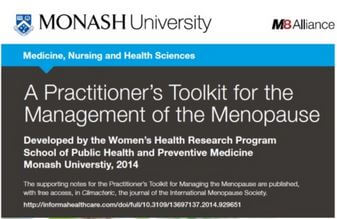Perimenopause and menopause are tricky to diagnose. Every woman knows it’s coming at some point but it can often be misdiagnosed as a side effect of something else that is going on. Until now, the guidelines for diagnosing menopause symptoms have been vague with women often going through months of suffering before a firm diagnoses is reached.
Thanks to Professor Susan Davis and Professor Fiona Jane at the Monash University in Australia the world now has a thoroughly researched and easy to use “Menopause toolkit” to help GP’s diagnose perimenopause and menopause. Not only that, it also suggests suitable treatment options based on the patients information. The toolkit was just published in Climacteric and it has been endorsed by the International Menopause Society for use globally.
How does The Practitioner Toolkit for managing menopause work?
The toolkit is a computer program that can be used all over the world. It combines the patient history with current symptoms and risk factors, it then takes existing menopause knowledge and some diagnostic algorithms and works out if the patient is experiencing menopause. The toolkit then suggests suitable treatment solutions.
Previously GPs had to work through a 40 page report in order to diagnose menopause, a lengthy procedure that mot many GPs have the time for. This toolkit cuts the time down to less than 10 minutes making correct diagnoses more viable. The toolkit gives the doctor clear guidelines and practical advice. It therefore reduces the chance of early menopause misdiagnoses and helps to avoid confusion over what course of treatment would work best for that individual.
Why the need for this toolkit?
Menopause is the time in a woman’s life when her menstrual cycle stops. Perimenopause are the years leading up to this, when the woman’s body gradually starts adjusting to the change. The process of menopause affects every woman differently so the symptoms can be hard to diagnose. It can also strike any time from 35 onward, although it’s more normal to start at around 41. Symptoms can include, mood swings, anxiety, loss of sex drive, hot flashes, weight gain around the belly, sleep disturbances, vaginal dryness/pain, headaches, memory loss, heavy or light periods and urinary infections. This menopause infographic has some more interesting information on menopause symptoms. For more information, you can also take a look at our previous blog post Dealing with the Perimenopause years.
In order to manage these symptoms most women start taking hormone replacement therapies. Like menopause itself, these treatments have to be tailored to the individual, depending on the severity of the symptoms and the individual’s needs. Having an easy to follow toolkit will help GPs diagnose and prescribe the most relevant medication. It also means that the chances of symptom relief are greater, faster.
You can take a look at the toolkit here


